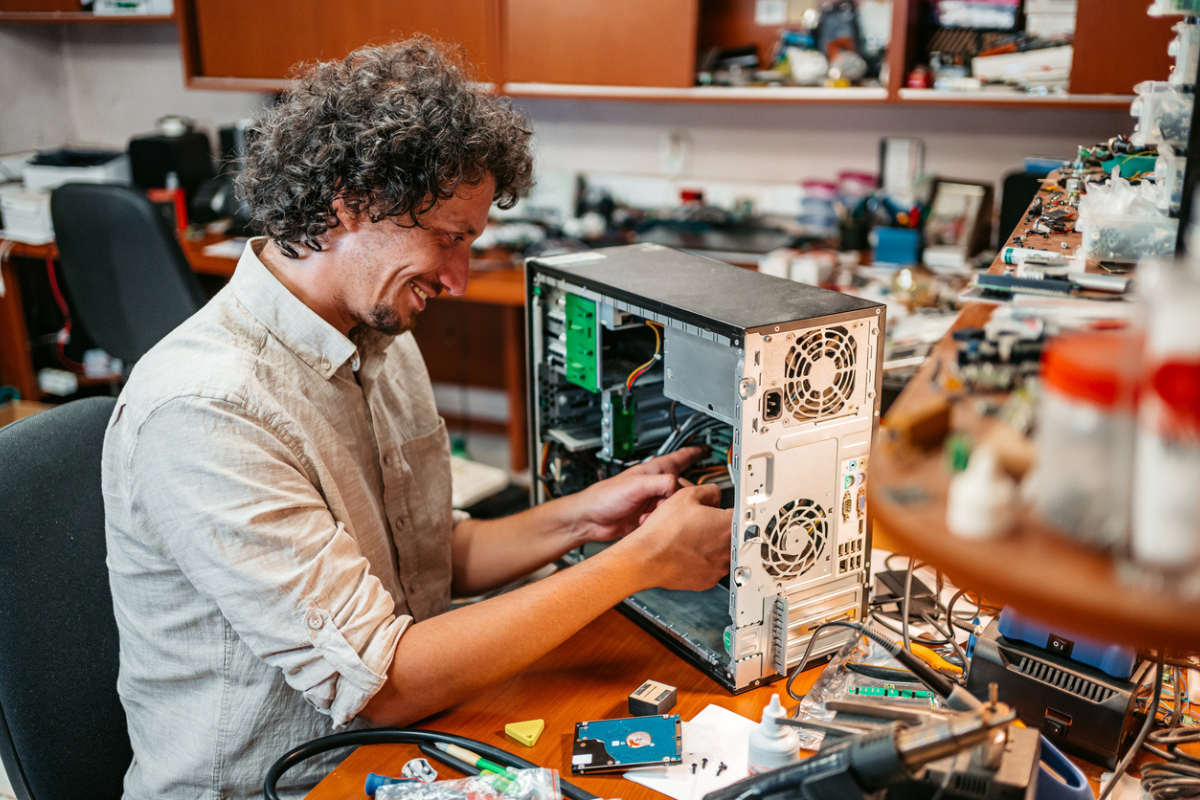The American View: When the Nest Empties—but the Cables Stay

My youngest moved out last weekend. We’re celebrating, obviously. Seeing your child “leave the nest” is supposed to be exhilarating ... and it was supposed to happen quite a while ago. My kid was originally hell-bent on moving out in January 2020 … and we all know how that year went. Lockdowns, tanked housing market, skyrocketing rents … It took until the end of 2024 for our region to stabilize enough for my kid to find a place he could afford on his salary. But here we are: it’s finally done. WOOT!
One negative aspect of his departure was the huge amount of left-behind possessions. We’d told our kid to sort through his stuff and clear out everything he wasn’t planning to take with him. He didn’t do that; instead, he focused on getting established in his flat and made vague (empty) promises to come back and sort everything out. No surprise then that my spouse and I had to clear everything out ourselves if we wanted to put his now-unoccupied room to use.
We knew our youngest was a packrat. He always had been. All his life he’s been staunchly opposed to the Marie Kondo décor philosophy. We’d known since our kid was a tot that whenever he griped about “not having any space” in his room it was his own danged fault for not actively managing his space. His Ikea dresser, for example, was completely full of old games, books, unfinished Gunpla kits, MtG cards, graded papers from middle school, old tools, etc. We were amazed by some of the stuff we sorted (and binned!).
Among the material we found was a pawn shop window’s worth of obsolete electronics. After four days of digging, we uncovered a gutted full-height tower PC case, two broken laptops, two long-fried tablets, five cheap android phones, three generations of iPods, a fourth-hand monitor, a colony of broken mice, a mechanical keyboard so caked with dust as to be unreadable, and enough cables to weave a fishing net. To be fair, most of our kid’s electronics were hand-me-downs, reconditioned used kit, and parts he’d gotten from his friends through trade. Every bit of it had been used to death … and some of it looked like it had been brought back through necromancy. Waste not, want not. [1]
That’s not a maladaptive behaviour in our extended family. We tend to wring every last drop of life out of our IT gear. We also don’t take anything to electronics recycling until we’re sure its storage has been fully overwritten. As we say in Texas, my kid comes by it honest. I appreciate his combination of frugality and mild paranoia towards keeping a reserve of useful parts. I’m confident this mindset will serve my kid well in the business world.

Consider that the academic models for how to run a successful business assume that most companies’ IT infrastructure and equipment are cost centres, not profit centres. That is, they’re necessary costs of doing business but don’t generate products or profits on their own. Therefore, a “smart” company should only purchase what the workers need to perform their core tasks and nothing more! Don’t spring for £100 ergonomic keyboards if disposable plastic £10 models will do. Don’t buy large monitors to lessen eye strain if small, fuzzy monitors will do. The network servers only have to work … not to work well, etc.
Additionally, it’s considered a best practice to keep expenses low by not stocking unused hardware or spare parts. Live that just-in-time logistics life instead! Why have the tools or parts you might need ready on a shelf when you can buy only what you need right after you need it? It’s not like you’ll ever find yourself in a technology-based emergency that can’t be put off for a few days …
Of course, as a former IT support person I can attest that this expense-minimization-focused academic model is suicidal nonsense. Sure, it keeps a “cost centre’s” budget low, but it also exposes the organisation to unnecessary operational risk. Minimal IT investment is only a competitive advantage so long as nothing ever goes wrong. Ask your help desk staff how many days they’ve gone without experiencing a drop-dead emergency in the last year. Go on … I’ll wait. [2]
This, I argue, is why us old school IT support types are famous for maintaining unofficial (and often hidden) stashes of operational spares, repair parts, cables, and adapters. When a busy executive’s laptop shorts out, they want a working replacement right now, not in 2-3 business days (weather permitting). One of the techniques we used in 2000s to address this risk was to keep a few laptop hard drives running out gold master image at the help desk walk-up service window. Whenever a user’s laptop went tango uniform, we’d simply remove the bad drive, pop in a new one, connect the “new” PC to the domain and send the user back to work in less than five minutes. Since all their apps were preloaded on the standard image and all the users’ documents were safely stored on the network, no work was lost. It was a small expense for parts and small investment of time to prepare that prevented tons of heartburn.
Additionally, we deliberately bought gear that allowed for growth and flexibility. We made sure that all our new PCs could be upgraded with more RAM, larger hard drives, popular peripherals, and the like. Once a user needed “more computer,” we already have the parts on hand to “improve” their PC on request. It was much cheaper than buying a whole new computer, but – more importantly – much faster than waiting on procurement. Of course we kept the old parts for spares; some RAM sticks might serve three or four times in different cases before they were retired.

Finally, when hit with massive budget cuts, we found ways to address our users’ needs by trading old kit with other like-minded IT support folks. I’d either lead or dispatch teams across the country to sites that were upgrading their IT gear. Whatever kit they were planning to send to the auction yard instead went into the back of a rented lorry. My techs signed for it, brought it home, then volunteered their weekends refurbishing it. We managed to turn over 400 “obsolete” PCs into up-to-date workstations that served our user base for the next two years at an “upgrade” cost of $100 each. No replacement budget? No problem!
MBAs will gripe that buying more capability “than you need” is wasteful and reduces profitability. That’s because they can’t see past their spreadsheets. Unfortunately, procurement and management types come from that MBA fairy tale world. They insist on always buying for today’s minimum requirements and refuse to stock emergency spare, repair parts, or special gear to address special needs. That’s where our community’s “packrat” mentality inevitably saves the day.
As much as it annoys me that my youngest left us a giant stack of old kit to sort, I get why he’d kept it. While I type this column, I can reach out and touch a stack of my “retired” work laptops on the shelf to my left. To my right, I have a three working keyboards on another shelf ready to return to work. Just around the corner in my supply closet, I have a stack at tall as I am of shoebox-sized bins labelled for their contents: Monitor Cables, AV Cables, Ethernet Patch Cables, USB A-B Cables, etc. I may not go into these stores very often, but every time I do it’s to solve a tech problem immediately instead of waiting 2-3 business days (weather permitting).
So, yeah. I’m proud of my youngest. He’s got good instincts for how to thrive in business and take care of his people despite managements penny-pinching instincts. Even better, my kid can now carry on his tech packrat’ing in his own space for a change. That’s good … I have a bin of Cat V and VI Ethernet cables in the garage that will fit perfectly in his closet …
[1] Per the old WW2 homefront slogan “Use it up! Wear it out! Make do or do without!”
[2] Cracks open a beer with sadistic anticipatory glee.
Most Viewed
The Expert View: Combatting Cyber-Threats at ScaleSponsored by Infoblox
Six key takeaways from CISOs on AI’s role in securitySponsored by Tines
How putting IT teams back in control can help reduce downtimeSponsored by ManageEngine
Tackling the cyber-threatSponsored by ManageEngine
Developing the foundations of resilienceSponsored by Zscaler
The necessity of API security for B2B fintechsSponsored by Raidiam
The Expert View: Achieving SaaS Security ExcellenceSPONSORED ARTICLE
The Expert View: Keeping Ahead of the HackersSponsored by Ekco
Winston House, 3rd Floor, Units 306-309, 2-4 Dollis Park, London, N3 1HF
23-29 Hendon Lane, London, N3 1RT
020 8349 4363
© 2025, Lyonsdown Limited. teiss® is a registered trademark of Lyonsdown Ltd. VAT registration number: 830519543




